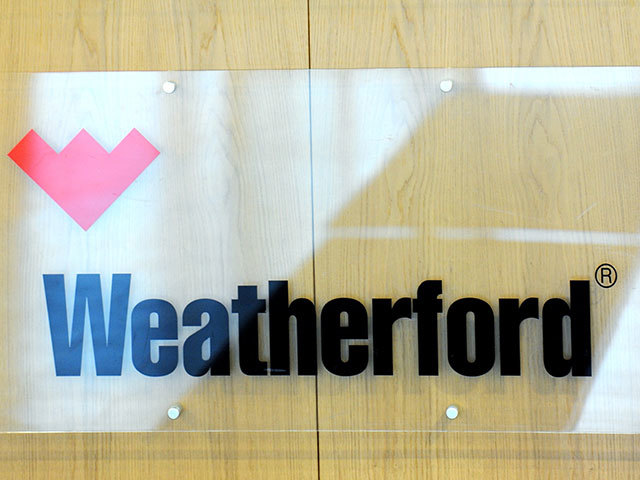
Weatherford International Plc shareholders are asking the company for one thing this quarter: Please, just be a little more boring.
Over the last decade, the oilfield services provider has missed analyst estimates 20 times, settled a corruption probe and spent more than $150 million in professional fees to fix errors in its accounting. And last month, it abandoned plans to raise $1 billion for an acquisition just hours after announcing them.
Now the company is seeking to build investor trust amid the worst oil market slump in decades. Chief Executive Officer Bernard Duroc-Danner needs to manage day-to-day activities in a way that will, for the first time in five years, generate more cash than the company spends, said David Anderson, an analyst at Barclays in New York. It’s a target Weatherford set for itself last year but failed to reach.
“Just be a little more boring,” Anderson, who rates the shares the equivalent of a hold, said in a phone interview. “The next 12 months are going to be really difficult in this market. They need to manage this downturn aggressively in order to survive.”
For most of this year, investors favored the company’s shares over those of rivals after it had sold off non-core businesses, settled the federal corruption investigation and put the accounting issues behind it. From January through late September, the stock was down 12 percent and still outperformed Schlumberger Ltd. and most of the other members of the Philadelphia Oil Services Index.
Yet since Weatherford announced an offering of stock and convertible notes to raise $1 billion for an acquisition on Sept. 21 and then canceled the plan the same day, it has been the second-worst performer in the 15-member index. The company had intended to use the money to be able to bid for Halliburton Co.’s drilling services assets that are up for sale, according to James Wicklund, an analyst at Credit Suisse in Dallas.
Weatherford is scheduled to release third-quarter earnings later today. Excluding certain items, it’s expected to report a loss of 11 cents a share, according to the average of 33 analysts’ estimates compiled by Bloomberg.
Investors will be looking to see if the company can deliver on its 2015 guidance of generating $150 million to $250 million in free cash flow. If that holds up, it would be the first time since 2010 it’s managed to generate more cash than it spent. Weatherford reported $487 million in negative free cash flow last year after earlier projecting it would be positive.
Unexpected costs have undermined the company’s efforts at producing free cash flow. Investors are generally worried about that happening again, Wicklund of Credit Suisse, who rates the shares a buy and owns none, said in a phone interview.
One example is the work Weatherford did in the Zubair oilfield in Iraq. In an effort to follow its competitors into that country, the company took a contract to build facilities that would aid in boosting production from the aging field, Anderson said. It was outside the company’s expertise in oilfield service work, he said.
The project contributed to Weatherford’s negative free cash flow last year, Chief Financial Officer Krishna Shivram told analysts and investors on an April conference call. The project is expected to be “cash neutral” in the second half of this year, the company said in July.
The accounting fix was also costly. Weatherford disclosed in March 2011 that it identified “material weaknesses” in its accounting system that the company said would result in adjustments of about $500 million to its financial statements for the periods from 2007 to 2010.
“What the market has wanted to see was the company exercise capital discipline, generate free cash flow and not screw up,” said Wicklund, who estimates that over five quarters in 2013 and 2014, the company spent $155 million in professional fees for lawyers and accountants “to clean up all their internal reporting structures, external reporting structures.”
Weatherford’s problems have come on top of what everyone else in the energy industry is going through after crude prices fell by more than half since June 2014, forcing companies to slash more than $100 billion in spending and 200,000 jobs around the world. Weatherford declined to comment for this story.
The company has said it’s trying to use this downturn to slash costs. The cuts include better integrating its collection of acquisitions from years past. The company was created through a number of mostly small deals over the years — only two were greater than $2 billion in size since 1991, according to data compiled by Bloomberg.
Executives say the lack of integration made it less efficient than larger competitors Schlumberger and Halliburton.
“They are better managed, but we’re younger,” Duroc-Danner told analysts and investors on an April conference call. “We understand that. We’re just taking actions to try to mature.”
Investors want to see the company deliver on it promises, Luke Lemoine, an analyst at Capital One Southcoast in New Orleans, said in a phone interview.
“It’s definitely a ‘show me’ story,” said Lemoine, who rates the shares the equivalent of a buy and owns none. “But I think the number one concern now is hitting that free cash flow target.”
Recommended for you
